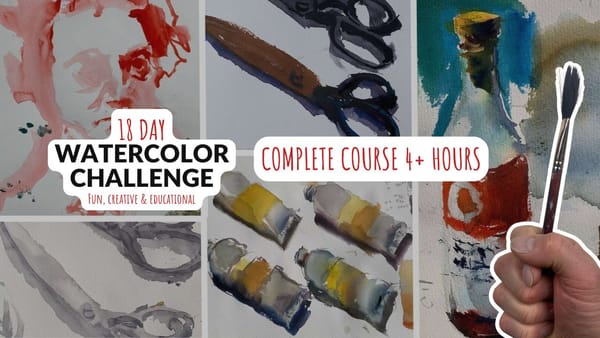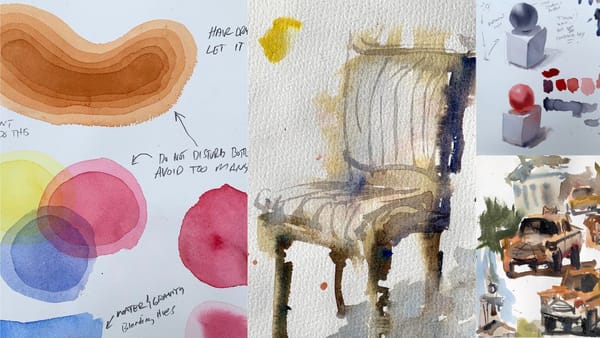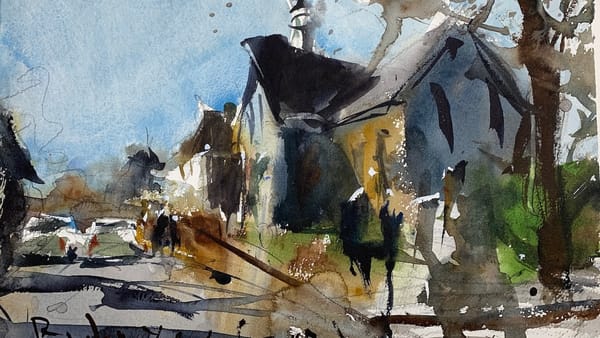Paint Loose Abstract Watercolor Faces
Tips for how to paint loose watercolor faces. Unleash your creativity and infuse emotion and expression into your artwork.

Watercolor painting offers a wide range of possibilities, from precise, realistic portrayals to loose, abstract expressions. In this blog post, we will delve into the exciting world of painting loose, abstract human faces using watercolors. We’ll take a unique approach by repurposing reject watercolor sketches and paintings as our starting point, infusing them with new life and creativity. Get ready to unleash your imagination and embark on a colorful journey!
Painting faces with watercolor video demo
Let’s Paint Loose, Abstract Faces with Watercolors
Prepare to breathe new life into rejects! Get ready for an exhilarating experience as you unleash your creativity and embrace the liberating freedom of applying paint and colors in a spontaneous and unrestricted manner.
- Choose your starting point: Select a watercolor sketch or painting that didn’t meet your initial expectations. Embrace imperfections and see them as opportunities for experimentation.
- Prepare your workspace: Set up your supplies, ensuring you have ample space to work and enough natural light.
- Assess and reimagine: Study your reject piece and identify elements you want to preserve or build upon. Consider how you can transform it into a captivating abstract face.
- Sketching and layout: Use a pencil or light watercolor wash to outline the basic features of the face. Keep the lines loose and fluid to maintain the abstract essence.
- Embrace color: Select a color palette that resonates with your desired mood or expression. Experiment with color combinations to evoke emotions and create depth.
- Bold brushstrokes and washes: Use large brushes and loose strokes to build the underlying structure of the face. Apply washes or glazes to add depth and dimension.
- Detailing and refinement: Gradually introduce smaller brushes for finer details. Focus on the eyes, lips, and facial features, maintaining the balance between abstraction and representation.
- Unleash your creativity: Feel free to incorporate various techniques like splattering, lifting, or dry-brushing to enhance texture and visual interest.
- Experiment with different faces: Once you feel comfortable with the process, try painting faces in different angles, expressions, and styles. Let your imagination guide you!
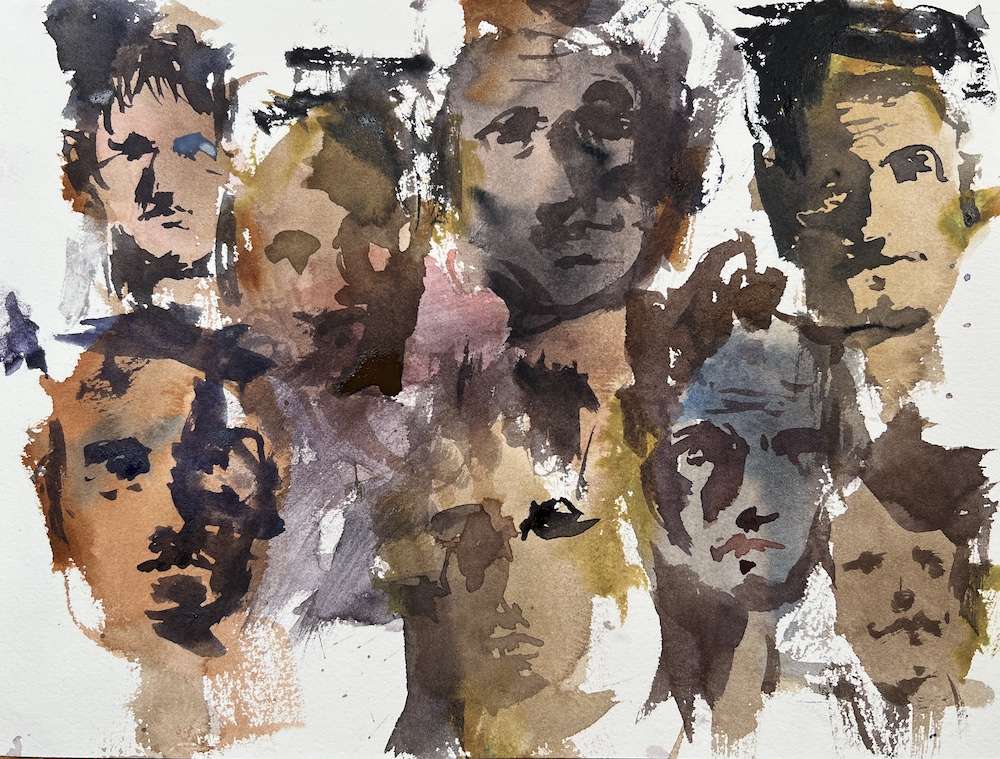
Understanding Loose and Abstract Art
Before we dive into the watercolor techniques, let’s take a moment to understand what it means to paint in a loose, abstract style. Loose art embraces freedom and spontaneity, allowing the artist to break away from rigid rules and expectations. Abstract art, on the other hand, focuses on the essence of the subject rather than its realistic representation. Combining these two styles, we can create vibrant and expressive human faces that capture the soul rather than the physical details.
Suggested Material Checklist
Materials can make or break the outcome of a watercolor study. Watch the video that covers the best watercolor materials if you need more specifics about color choices, brush sizes and such. Basically, it’s exactly what I use and recommend for all levels.
Watercolor Paints: Opt for artist-grade watercolor paints in a range of colors. Choose a basic palette that includes six primary colors (one cool and warm hue for each one including red, blue, and yellow) along with earth tones for a versatile collection.
If you aren’t aware of the six primary palette, then check out our in-depth article on how to mix watercolors for beginners. It has the exact hues I use for every painting. And, if I make changes, I always update the article so you know the exact hues that get the best results.
Brushes: Invest in a set of good-quality watercolor brushes with different shapes and sizes. Round brushes are excellent for detailed work, while flat brushes are great for larger washes. I’d recommend one medium and one large pointed round. Then get a large mop brush that will handle those initial washed that are applied in the very beginning.
You only need three brushes to do most of the heavy lifting! However, I do recommend having a dagger and possibly and Motler on hand as well. Check out the article I wrote on how to choose the best watercolor brushes if you have questions on the exact brands, sizes and such.
Paper: I highly recommend selecting watercolor paper specifically designed for this medium. Look for papers labeled “cold-pressed” or “hot-pressed” to suit your preferred texture. Experiment with different weights and brands to find the one that suits your style. Most beginners choose 140 lb. cold press to start their journey. Hot press tends to be a little slick and most used for highly detailed work and portraits.
Avoid cheap, wood pulp papers as they don’t react properly to washes and other techniques. These cheaper papers tend to break down quickly and don’t age well either, basically yellowing over time. Be sure to read the how to choose the best watercolor paper article when you have time.
If you aren’t aware of the six primary palette, then check out our in-depth article on how to mix watercolors for beginners. It has the exact hues I use for every painting. And, if I make changes, I always update the article so you know the exact hues that get the best results.
Palette: A palette is essential for mixing and diluting your watercolors. Choose a palette with wells to hold different colors and a large mixing area. Small palettes tend to get dirty too quick and I found it difficult to have enough free space to mix enough colors without having to stop everything to clean up. The Masterson Pro palette works great and available at Amazon and Blick Art.
Water Containers: Have at least two containers for water—one for rinsing your brushes and another for clean water. Make sure the containers aren’t too small, and I would recommend plastic over glass. I’ve had plenty of studio accidents and cleaning up shattered glass isn’t ideal when in a creative mode.
Masking Tape and Drawing Board: Masking tape helps secure your paper to a drawing board, keeping it flat and preventing it from warping. The tape is optional and depends if you prefer the clean edges. In the beginning you will most likely focus on sketches and studies, so maybe pass until you determine later on if you need it.
A smooth, firm board is a must! I recommend Gator foam board as it’s very sturdy, smooth and durable. Fairly inexpensive and light weight to boot. That covers materials, let’s move on to skills you need to start watercolor painting.
Other Supplies
Scrap paper or rejected watercolor sketches: These will serve as the foundation for your loose, abstract faces.
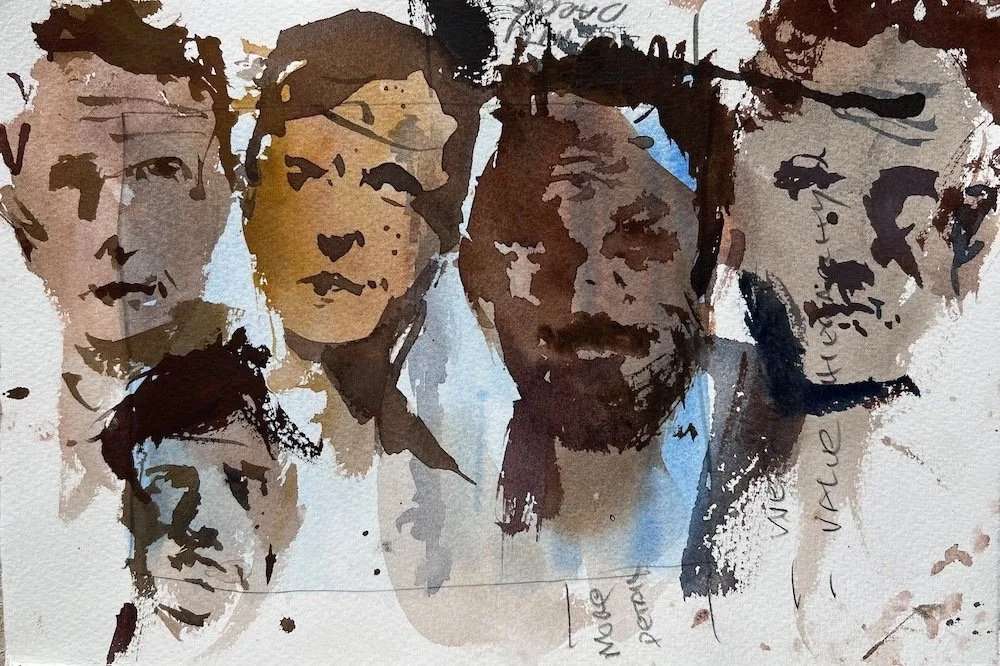
The Joy of Random Faces
One of the greatest joys of painting loose, abstract human faces is the element of surprise. By using rejected sketches and paintings as a starting point, you’re embracing imperfections and allowing spontaneity to guide your brush. This sense of freedom opens up a world of creative possibilities. Each stroke of the brush becomes an exploration, an adventure into the realm of color, shape, and emotion.
Embracing imperfections: Reject watercolor sketches and paintings often carry a sense of disappointment or frustration. However, when approached with an open mind, these “imperfect” pieces can become a foundation for something extraordinary. Embrace the unique textures, drips, and splatters as they add character and depth to your abstract faces.
Unleashing spontaneity: With loose and abstract art, you have the freedom to let go of control and allow your intuition to guide you. There’s no need to be overly concerned with achieving a perfect likeness. Instead, focus on capturing the essence and emotions of the subject. Trust your instincts and embrace unexpected outcomes.
Expressing emotions through color: Watercolor offers a vast range of hues and tones, allowing you to convey a wide spectrum of emotions. Experiment with bold and vibrant colors for joy and energy, or subtle and muted tones for introspection and serenity. Play with color contrasts to create visual impact and evoke specific feelings in your artwork.
Playing with composition: Traditional portraiture often adheres to conventional rules of composition. However, in the realm of loose, abstract art, you have the freedom to experiment with unconventional arrangements. Explore asymmetry, overlapping shapes, and dynamic angles to create visually engaging compositions that defy expectations.
Capturing the essence of humanity: The beauty of painting human faces lies in capturing the essence of a person—their emotions, thoughts, and experiences. Through loose and abstract techniques, you can distill the essence of a face, focusing on the eyes, the tilt of the head, or the suggestion of a smile. Allow your viewers to connect with the soul behind the paint, rather than the physical features.
Embracing happy accidents: Watercolor is notorious for its spontaneous nature, often leading to delightful surprises on the paper. Embrace these happy accidents as they add a sense of spontaneity and uniqueness to your artwork. A dripped color or a unexpected blend can spark new ideas and take your painting in unexpected directions.
Building a personal style: Through exploration and experimentation, you’ll develop your unique style and voice as an artist. Painting loose, abstract human faces provides an avenue for self-expression and personal growth. Embrace the journey of discovering your signature techniques, color palettes, and brushwork that make your artwork uniquely yours.
Conclusion
Painting loose, abstract human faces with watercolors is a thrilling artistic endeavor that allows you to break free from constraints and embrace the joy of creative exploration. By repurposing rejected watercolor sketches and paintings, you breathe new life into them, transforming imperfections into artistic opportunities.
Through color, composition, and bold brushwork, you can capture the essence of humanity in a way that is both expressive and evocative. Embrace the element of surprise, playfulness, and spontaneity that come with this style, and watch as your art takes on a life of its own. So, grab your brushes, let go of control, and dive into the vibrant world of loose, abstract watercolor faces—where the beauty lies in the journey itself.
